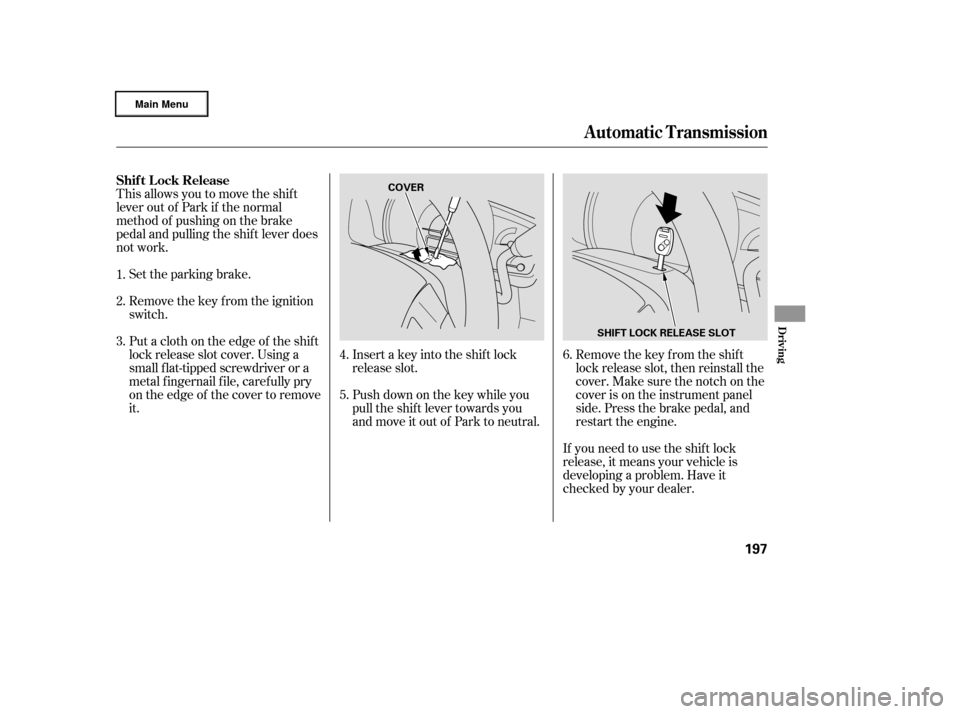Page 196 of 320
These indicators on the instrument
panel show which position the shif t
lever is in.The ‘‘D’’ indicator comes on f or a
f ew seconds when you turn the
ignition switch to ON (II). If it
f lashes while driving (in any shif t
position), it indicates a possible
problem in the transmission.
If the malf unction indicator lamp
comes on along with the ‘‘D’’
indicator, there is a problem in the
automatic transmission control
system. Avoid rapid acceleration, and
have the transmission checked by
your dealer as soon as possible.
To shif t f rom Park to any position,
pressfirmlyonthebrakepedal,and
pull the shif t lever toward you. You
cannot shif t out of Park when the
ignition switch is in the LOCK (0) or
ACCESSORY (I) position.
CONT INUED
Shif t L ever Position Indicators Shif ting
Automatic Transmission
Driving
193
SHIFT LEVER
�����—�
���—�����y�
�������������y���
�(�����������y���
�����y
Page 197 of 320

�µ�µ�µ
This position mechani-
cally locks the transmission. Use
Park whenever you are turning of f or
starting the engine. To shif t out of
Park, you must press on the brake
pedal and have your f oot of f the
accelerator pedal. Pull the shif t lever
towards you, then move it out of
Park.
If you have done all of the above and
still cannot move the lever out of
Park, see on
page .
You must also pull the shif t lever
towards you to shift into Park. To
avoid transmission damage, come to
a complete stop bef ore shif ting into
Park. The shif t lever must be in Park
for you to remove the key from the
ignition switch. Press the brake
pedal and pull the shif t lever towards
you to shif t f rom Park to reverse. To
shif t f rom reverse to neutral, come
to a complete stop, and then shif t.
Pull the shif t lever towards you
bef ore shif ting into reverse f rom
neutral.
Use neutral if you
need to restart a stalled engine, or if
it is necessary to stop brief ly with
the engine idling. Shif t to the Park
position if you need to leave your
vehicle for any reason. Press on the
brake pedal when you are moving
the shift lever from neutral to
another gear.
197
To shift from:
PtoR
RtoP
NtoR Dto2 2to1
1to2
2toD
DtoN
NtoD RtoN Do this:
Press the brake pedal, and
pull the shift lever towards
you.
Pull the shift lever towards
you.
Move the shift lever.
Automatic Transmission
Park (P)
Shif t L ock Release Reverse (R)
Neutral (N)
194
�����—�
���—�����y�
�����������
�y���
�(�����������y���
�����y
Page 199 of 320

�µ
�µ To shif t f rom second to
first, pull the shift lever towards you,
then shif t to the lower gear. This
position locks the transmission in
f irst gear. By upshif ting and
downshif ting through 1, 2, and D,
you can operate the transmission
much like a manual transmission
without a clutch pedal.
To shif t to second,
pull the shif t lever towards you, then
shif t to the lower gear. This position
locks the transmission in second
gear. It does not downshif t to f irst
gear when you come to a stop.
Use second gear: For more power when climbing.
To increase engine braking when
going down steep hills.
For starting out on a slippery
surf ace or in deep snow.
To help reduce wheel spin.
When driving downhill with a
trailer.
When towing a trailer on level roads
under normal driving conditions, do
not use D3. This will increase the
automatic transmission fluid
temperature and may cause
overheating.
Shif ting out of the D position will
cancel D3, and cause the D3
indicator to go out. Selecting the D
position again will resume D3, and
the indicator will come on.
Turning the ignition switch to LOCK
(0) turns D3 of f . To use D3 when
you restart the engine, select the D
position and press the D3 switch
again.
TheD3indicatoralsocomesonfora
f ew seconds when you turn the
ignition switch to ON (II).
If you shif t into f irst position when
the vehicle speed is above 28 mph
(45 km/h), the transmission shif ts
into second gear first to avoid
sudden engine braking.
If you exceed the maximum speed
f or the gear you are in, the engine
speed will enter into the tachometer’s
red zone. If this occurs, you may f eel
the engine cut in and out. This is
caused by a limiter in the engine’s
computer controls. The engine will
run normally when you reduce the
rpm below the red zone.
Automatic Transmission
First (1)
Engine Speed L imiter
Second (2)
196
�����—�
���—�����y�
�������������y���
�(�����������y�������
�y
Page 200 of 320

This allows you to move the shif t
lever out of Park if the normal
method of pushing on the brake
pedal and pulling the shif t lever does
not work.Push down on the key while you
pull the shif t lever towards you
and move it out of Park to neutral.Remove the key from the shift
lock release slot, then reinstall the
cover. Make sure the notch on the
cover is on the instrument panel
side. Press the brake pedal, and
restart the engine.
Set the parking brake.
Remove the key from the ignition
switch.
Put a cloth on the edge of the shif t
lock release slot cover. Using a
small f lat-tipped screwdriver or a
metal f ingernail f ile, caref ully pry
on the edge of the cover to remove
it.
Insert a key into the shift lock
release slot.
If you need to use the shif t lock
release, it means your vehicle is
developing a problem. Have it
checked by your dealer. 6.
1.
2.
3.
4.
5.
Automatic Transmission
Shif t L ock Release
Driving
197
SHIFT LOCK RELEASE SLOT
COVER
�����—�
���—�����y�
���������
���y���
�(�����������y���������y
Page 205 of 320

If the brake pads need replacing, you
will hear a distinctive, metallic
screeching sound when you apply
the brake pedal. If you do not have
the brake pads replaced, they will
screech all the time. It is normal f or
the brakes to occasionally squeal or
squeak when you apply them. Check the brakes after driving
through deep water. Apply the
brakes moderately to see if they f eel
normal. If not, apply them gently and
f requently until they do. Be extra
cautious in your driving.
The hydraulic system that operates
the brakes has two separate circuits.
Each circuit works diagonally across
the vehicle (the lef t-f ront brake is
connected with the right-rear brake,
etc.). If one circuit should develop a
problem, you will still have braking
at two wheels.
Your vehicle is equipped with disc
brakes at all f our wheels. A power
assist helps reduce the ef f ort needed
on the brake pedal. The anti-lock
brake system (ABS) helps you retain
steering control when braking very
hard.
Resting your f oot on the pedal keeps
the brakes applied lightly, builds up
heat, increases wear, and reduces
their ef f ectiveness. It also keeps
your brake lights on all the time,
conf using drivers behind you.
Constant application of the brakes
when going down a long hill builds
up heat and reduces their ef f ective-
ness. Use the engine to assist the
brakes by taking your f oot of f the
accelerator and downshif ting to a
lower gear.
If the vehicle is f acing uphill, turn
the front wheels away from the
curb, and set the parking brake.
If the vehicle is f acing downhill,
turn the front wheels toward the
curb, and set the parking brake.
Make sure the parking brake is
f ully released bef ore driving away.
Driving with the parking brake
partially set can overheat or
damage the parking brake.
Brake Wear Indicators Braking System Design
Braking System
Parking, Braking System
202
�����—�����—�����y�
����
��������y���
�(�����������y���������y
Page 210 of 320

The maximum weight of the trailer
andeverythinginoronitdependson
the number of occupants in your
vehicleandthetypeof trailerbeing
towed (see page ).
Towing a load that is too heavy can
seriously af f ect your vehicle’s
handling and perf ormance.
Your vehicle has been designed to
tow a trailer, as well as carrying
passengers and their cargo. To
safety tow a trailer, you should
caref ully observe the load limits (see
page ), use the proper equipment,
and f ollow the guidelines in this
section.
Be sure to read the
sectiononpage
if you plan to tow of f paved
surf aces.
The weight that the tongue of a f ully-
loaded trailer puts on the hitch
should f ollow the recommended load
guidelines (see page ). Too
much tongue load reduces f ront-tire
traction and steering control. Too
little tongue load can make the
trailer unstable and cause it to sway.
209
183
219
209
Towing Weight Limits
T ot al T railer WeightT ongue L oad
Load Limits
Off-Highway
Driving Guidelines
Driving
207
Exceeding any load limit or
improperly loading your vehicle
and trailer can cause a crash in
which you can be seriously hurt
or killed.
Check the loading of your
vehicle and trailer carefully
beforestartingtodrive.
�����—�����—�����y�
����
��������y���
�(�����������y�����
���y
Page 211 of 320

�µ�µ
�µ The maximum
allowable weight of the vehicle, all
occupants, all cargo, and the tongue
load is 6,050 lbs (2,745 kg).
The maximum
allowable weight on the vehicle axles
is 3,105 lbs (1,410 kg) on the f ront
axle, and 3,245 lbs (1,475 kg) on the
rear axle.
The maximum
allowable weight of the f ully loaded
vehicle and trailer is 10,088 lbs
(4,575 kg) with the proper hitch.
The GCWR must be reduced 2
percent f or every 1,000 f eet (305
meters) of elevation. Thebestwaytoconfirmthatall
loads are within limits is to check
them at a public scale (see page
).
Add the weight of your trailer (as
quoted by the manuf acturer) with
everything in or on the trailer. Then
check the tables on page to
make sure you do not exceed the
limit f or your conditions. To help ensure a saf e drive to a scale,
or if you cannot get to a public scale,
we recommend that you estimate
your total trailer weight and tongue
load as described. 207
209
Estimating Loads
Gross Vehicle Weight Rating
(GVWR)
Gross Axle Weight Rating
(GA WR)
Gross Combined Weight Rating
(GCWR)
To Estimate the Total Trailer Weight
Towing Weight Limits
208
�����—�
���—�����y�
���������
���y���
�(�����������y�����
���y
Page 212 of 320
�Î�Î�Î
�Î
�Î�Î
�µ�µ
Number of
Occupants 2
3
4
5 Max. T railer Weight Max. T ongue Load
Towing Weight Guidelines
Driving
209
Total Trailer Weight and Tongue Load Guidelines:
The corresponding weight limits assume occupants fill seats from the front of the vehicle to the back, each occupant weights 150 lbs (70 kg),
and each has 15 lbs (7 kg) of cargo in the cab, pickup bed, or In-Bed Trunk. Any additional weight, including cargo or accessories, reduces
the maximum trailer weight and maximum tongue load. Never exceed the gross axle weight ratings (see page ).
Recommended tongue load should be 5 15% of the total trailer weight for boat trailers, and 10 15% of the total trailer weight for all other
trailers.
208
5000 lbs (2268 kg)
4750 lbs (2155 kg)
4750 lbs (2155 kg)
4500 lbs (2041 kg)
600 lbs (272 kg)
600 lbs (272 kg)
570 lbs (258 kg)
516 lbs (234 kg)
�����—�����—�����y�
����
��������y���
�(�����������y�����
���y